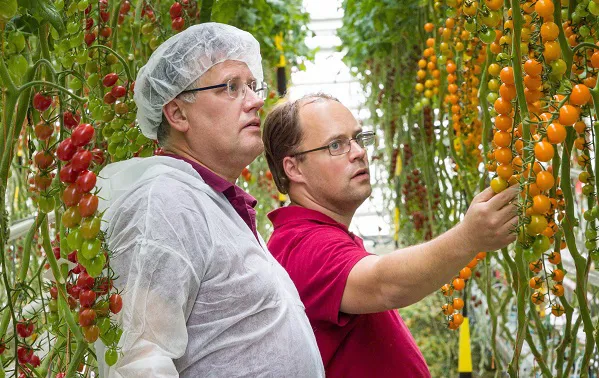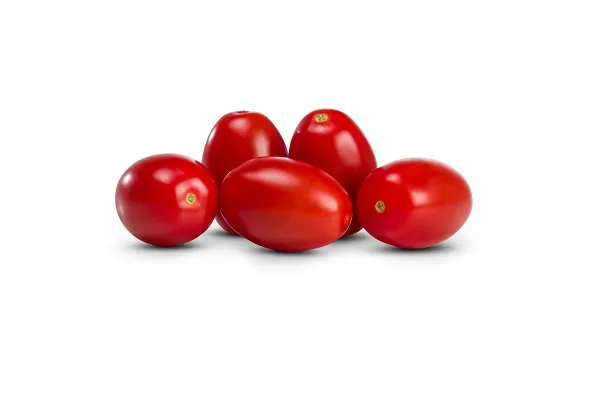There are snack tomatoes everywhere these days. Consumers are currently obsessed with them. People have a huge choice, which bodes well for trading companies. Every year, they get many new snack tomatoes varieties from which to choose. This year, there are three, no four, new Sakata varieties, in red, yellow, and brown. “There is always room in the market for a unique tomato of its kind, and with good flavors and shelf life, we now have those varieties ready.”

Pieter Vermeulen in action at Delphy with Paul van der Nat of Delphy. Photo credit: Pieter Prins
That is, according to Pieter Vermeulen, who is the high-tech Indoor Crop Specialist at Sakata in the Netherlands. As such, he is responsible for the sale and development of, among others, new snack tomatoes in NW Europe. He sums up the latest additions and ends up with five. Lemonstar F1, Scarlet Star F1, Crimson Star F1 are brand new varieties. Chocostar F1 was introduced a year ago, and Bellastar F1 is better known on the market already.
The common denominator - each has the word ‘star’ in its name. At Sakata, varieties with flavor profiles above the Sakata determined threshold, get a ‘star’ in their name, explains Pieter. “Of all the varieties, Bellastar F1 is best typified as a ‘commodity’. It is a high production variety with good fruit weights and short bunches. It, therefore, costs less for growers to cultivate. It does not have the most pronounced taste, but on the other hand, it does have a very good shelf life,” says Pieter.
Their shelf life distinguishing them
Building on Bellastar F1’s strengths, Sakata has developed two new, red snack tomato varieties. “Both the Scarlet Star F1 and Crimson Star F1 have improved, stronger, more pronounced flavors than the Bellastar F1. The Crimson Star F1 also comes into production very early and is very suited to lit cultivation. This variety, if grown correctly, can compete with its rivals on the market. The crux is to prune the bunches, which allows farmers to maintain good fruit weights.”
Traders and, ultimately, retailers, or whomever the seller is, may not see the use of pruning these tomato bunches. But Pieter expects shelf life, which distinguishes especially the Scarlet Star F1 from its market contemporaries will appeal to these parties. “It is, after all, essential that a tomato keeps well and also presents well. Uniformity - in shape, fruit weight, as well as flavor - plays a role in this. Everyone wants a nice-looking, flavorful tomato that does not disappoint, throughout the year.”
No inconsistency allowed
Besides the newcomers, Scarlet Star F1 and Crimson Star F1, Sakata also have a new yellow snack tomato. The name - Lemonstar F1 - betrays the color. “There are relatively few yellow snack tomatoes on the market,” says Pieter, “so, I see opportunities with this new variety. It has a uniform fruit weight, high production, and, above all, it tastes good.
With a year-round Brix level of more than 8.0, the Lemonstar makes for a perfect yellow fruit in the mixed packs. But it is not just all about the Brix level. Brix levels are important, but it is more about having a good balance between sweet and sour. The brown Chocostar F1 snack tomato also does well in mix packs. A large Belgian grower is well pleased with this variety’s taste, fruit weight, and shelf life.”
To be able to make statements about flavor, Sakata gets multiple test panels to taste the varieties. These are both in the Netherlands, at Wageningen University & Research, and the ISA Institute in Lille, France. “Varieties must score well with taste throughout the year. Their flavor may not deviate, like lagging in the spring or autumn, for instance. You cannot afford that if you are using a variety to forge a position in stores.”

According to Pieter, the Scarlet Star variety should appeal to traders and sellers, thanks to its good shelf life. Photo credit: Pieter Prins.
More than 12g is too big
Besides his contact with the chain’s sales side, Pieter is also in close contact with farmers. “Growers want high production, and face pressure from market developments and demands. We, as a breeding company, respond to that, but, at the same time, we must resist the temptation of combining high production with weighty fruit and inferior flavors. The focus must remain on how these tomatoes taste.” That is why Pieter focuses on trading companies. “They choose which varieties they want to buy and sell.”
Pieter has seen that due to the market’s emphasis on high production, snack tomatoes have gradually gained weight over the years to about 10g, but sometimes even 14, 15 or 16g “It is striking that recent taste panels tests show that the larger sizes were actually too big for the tasters. Some found 12g even to be too big. We, therefore, focus on developing varieties of between ten and 12g.”
Mixes
Flavor is important to entice people into buying and eating tomatoes and ensure repeat purchases, but it is, firstly, what consumers see that makes them choose a tomato. Mixed packs, full of color, not only look good, they help with this too. “In such a mixed pack of different colors, it is the tomato variety with the worst shelf life that determines its success. We, therefore, pay close attention to uniform shelf life and focus on an expansive snack tomato assortment, with all sorts of colors that taste good and last long.”
What does help to determine which new varieties to bring to market, is that more farmers are in increasingly better control, Pieter sees. “So, the grower chooses which tomato ensures the best possible product at a low cost. If a new variety outperforms its competitors on the market when it comes to harvesting performance, as well as costs, flavor, shape, and shelf life, the choice is easy. Traders, who look beyond just volumes, will then also enter the market more easily with a new variety. In short, get the ball - or seeds and later, snack tomatoes - rolling. With these new varieties, we are ready.” (TT)
More information
Pieter Vermeulen Sakata
Sakata
pieter.vermeulen@sakata.eu
www.sakata.com
